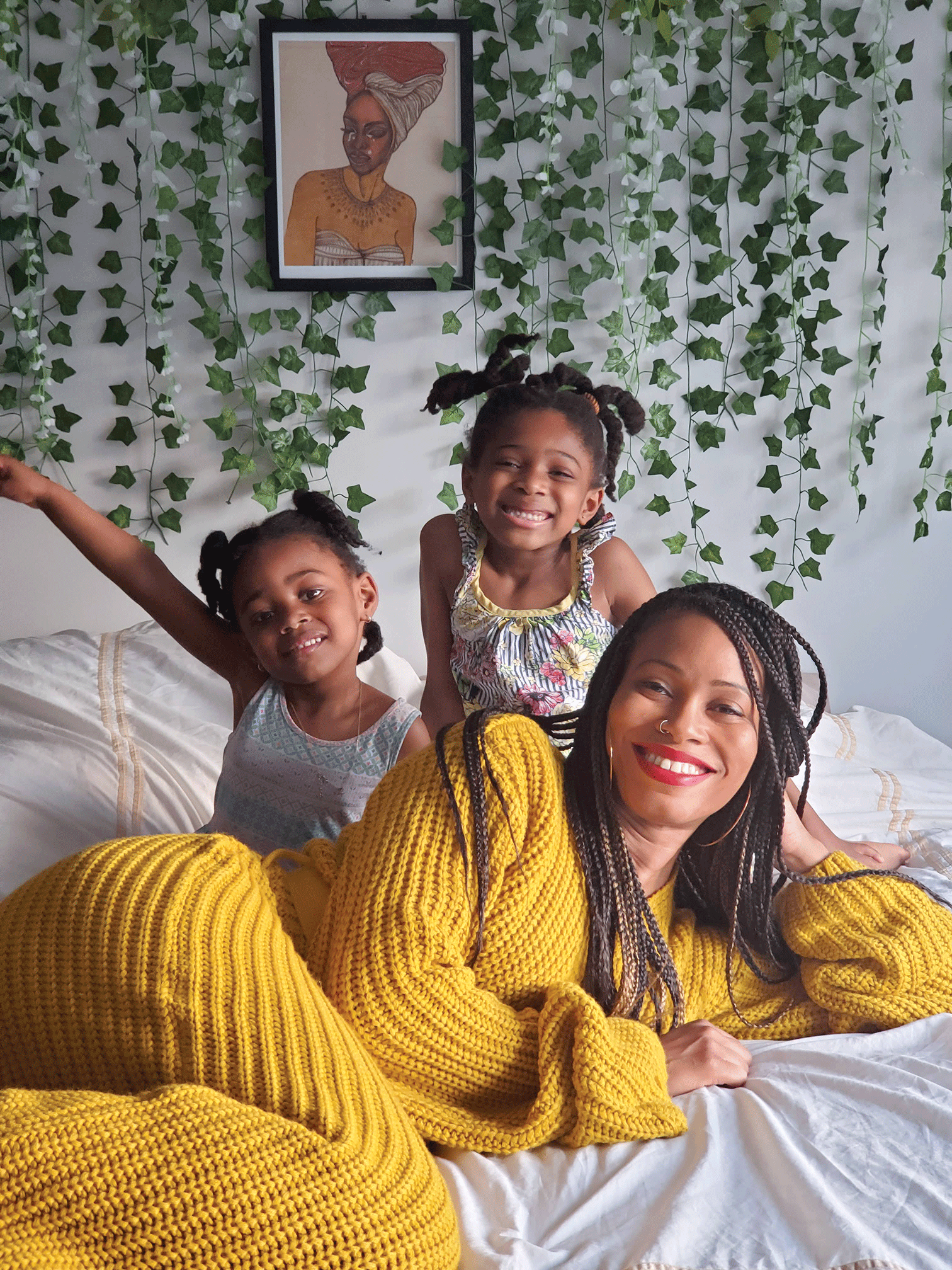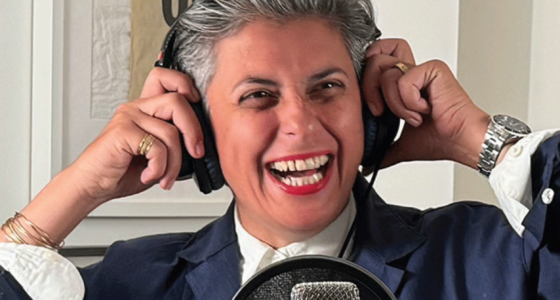It’s never been easy to be a journalist and a mother. Now it’s harder.
Bee Quammie creeps down the stairs of her Oshawa townhouse, trying her best to embody silence, holding her breath to prevent her one-year-old, Layla, from waking up. It’s just past 7 p.m. on a late spring night in 2016, and it’s getting dark. When she reaches her living room, she flops onto the couch and retreats under a blanket. But she only has a moment to relax before her phone pings with a self-set reminder: “Did you apply for Yale yet?”
Quammie learned about the THREAD at Yale fellowship, an offshoot of the Yale Journalism Initiative, a month earlier. It was launched in 2006 to offer people at Yale and beyond an entry into journalism. If Quammie were to be accepted, she would get to travel to the New Haven campus and have one of her works in progress picked over and perfected. She’s been meaning to apply ever since first hearing about it—but now only has five hours until the application is due. Five hours to compile a letter of intent, past pieces of her work, and an example of a work in progress she wants to workshop.
Quammie makes her way over to her workstation in the corner of the room, rubs her eyes, and opens her laptop. As a health-care worker and freelance writer on top of being a mother to a toddler, she is busy and tired. She’s unsure if she can complete the application in time. But, as a Black woman in Canada trying to kick-start her freelancing career, she feels she owes it to herself to try.
As soon as she sits down, there’s a familiar wail, one so loud she doesn’t need the ever-present baby monitor to hear it. With her husband working nights, Quammie is alone, on solo baby duty. Shouldering a fleeting feeling of resentment at the situation, then a deeper sense of guilt, Quammie consoles Layla. Perhaps this is a sign, she thinks, rocking Layla back to sleep, that it is too early in her daughter’s life to prioritize anything else above being a mom.
Since Quammie has become a mother, this thought has been drilled into her brain over and over again, sometimes by the people around her, sometimes by her own doubts, but most of the time, by the dire state of the Canadian journalism industry. The number of full-time jobs has decreased, while the amount of casual or part-time work has greatly increased, making it harder for parents to receive maternity benefits through EI or to afford daycare. Add in journalism’s demanding, inconsistent hours, and it’s hard for parents to be the journalists they want to be—or the parents they want to be. It’s easy to see why Quammie has some doubts.
Almost three decades ago, in 1992, this magazine published Eva Janssen’s “Days and Nights on the Kid Shift.” The article follows Patricia Orwen, then a Toronto Star staff reporter whose children were three and two years old. It opens with Orwen shuttling her children to daycare, before beginning her own busy day at work. Janssen keenly captures the waning of Orwen’s patience and the chaos of her life.
In 1992, Orwen shared a position with another staff member at the Star, one of the many newspaperwomen who reduced their hours to balance time with their families. According to Janssen’s reporting, while the Star boasted a one-year maternity leave at the time, it did not provide much more in the way of help for women returning to work after having children. However, with her ambition and workload unchanged, Orwen found herself doing part-time work and running a household all while trying to take care of her children.
When asked if the current system is any more equitable for working mothers, Nora Loreto, editor for the Canadian Association of Labour Media and author of Take Back the Fight: Organizing Feminism in the Digital Age, says, “Absolutely not.”
“Things have gotten much worse, and worse in very pernicious ways,” she explains. “The neoliberal state has downloaded so many responsibilities onto families, which so often fall on the women’s shoulders.”
These responsibilities include making sure everyone is fed, clothed, on their way to school or focusing on their online classes, scheduling appointments, keeping the house clean, and looking after elderly family members—on top of having a full-time job.
Loreto, a mother to seven-year-old twins, has heard horror stories of friends having to get their unions involved just to access the basic rights enshrined in their collective agreements. And, she says, it’s difficult to be a parent and simultaneously fuel your own soul through meaningful work. “That feeling that you can’t do exciting projects,” she says, “is really, really hard to manage.”
She adds: “I think we have glossed over a veneer that things are okay, so it’s really hard to talk about how things aren’t.”
In a November 2019 article for The Tyee titled “The Long Decline of Canadian Journalism,” researcher and writer Sabrina Wilkinson wrote that the Labour Force Survey, conducted monthly by Statistics Canada, is the only available source of current employment estimates. Its data set provides information about journalists who are employed by news organizations and those who are self-employed. During the first decade of the data set, 1987 to 1996, the survey found that five percent of Canadian journalists worked as freelancers, while 70 to 80 percent worked permanent staff jobs. Over the past decade, the share of journalists earning their incomes through freelancing jumped to 17 percent.
Meanwhile, freelance rates have fallen precipitously. In a piece for Medium’s Forge vertical, American journalist Malcolm Harris pegs the standard pay for an article in 1977 at $500—the equivalent of over $2,000 in today’s dollars. “A single dollar has lost nearly 87 percent of its value,” Harris writes, “and so have the words of professional freelance writers.”
The Canadian Media Guild estimates that in the past few decades Canada has lost 12,000 journalism positions—and the past year has been particularly tough in terms of layoffs and job cuts. According to J-Source, which tracked journalism layoffs over a six-week period ending April 29, 2020, the pandemic further weakened an already hard-hit industry. J-Source found that 50 news outlets had temporarily or permanently closed, 19 newspapers had cancelled some or all print editions, 78 outlets had reported layoffs or job losses, and 2,053 editorial and non-editorial staff had been laid off.
The Canadian Media Guild estimates in the past few decades Canada lost 12,000 journalism positions—and the past year has been tough.
In April, Torstar eliminated 85 positions. In July, Global News laid off a significant number of employees. In October, CBC announced 130 layoffs. In November, Postmedia announced that it would be laying off about 40 employees. And in March of 2021, BuzzFeed bought out Huffington Post Canada just weeks after its staff unionized, then collapsed the Canadian bureaus.
Ashley Espinoza, a former reporter for the Napanee Beaver, just won a Human Rights case against the paper after experiencing one of those horror stories Loreto mentioned.
Espinoza began working as a reporter for the Beaver in 2013. Her two colleagues, both men, had children and remained working for the Beaver, so when she became pregnant with twins in 2015 she wasn’t sure how it would affect her career.
That same year, Jean Morrison, the president of the paper, began receiving assistance in overseeing day-to-day operations from her daughter, Tracey Lindberg, who lives in Collingwood, Ont. (a four-hour drive from Napanee).
Espinoza left work on a medical leave in June 2016 and gave birth to her twins that August. When they were around four months old, she began searching for a daycare. She wanted somewhere that would take both of them, and was between her home and where her husband was living, because she often worked late after covering town council and the theatre committee for Napanee, Lennox, and Addington. When she could not find the right daycare almost three months before the end of her maternity leave, she contacted Lindberg to work out a schedule for when she returned.
Lindberg did not get back to her for over 40 days. Finally, 11 days before Espinoza was to go back to the office, Lindberg emailed her, declining her request for modified work hours. Espinoza was left at a crossroads.
“Did having twins just ruin my career?” Espinoza recalls asking her mother on the phone one day.
What ensued was a three-year process of Espinoza taking the Beaver to the Human Rights Tribunal of Ontario. Finally, on January 20, 2021, the HRTO ruled that the Beaver did not fulfill its duty to accommodate Espinoza’s rights to be a mother and a journalist, concluding that because the employer didn’t look into alternative accommodations, Espinoza was forced to choose between her children and her career.
Although Espinoza is relieved that she won the case and that the ordeal is over, she is still angry and hurt at the thought of losing her career. “I had wanted to be a journalist since I was a little girl,” she says. “The only thing that I knew I wanted to be was a reporter, which is why it kills me so much, because this has cost me my career.
“There’s been a lot of therapy, there’s been a lot of tears, and there’s been a lot of days where I did not want to get out of bed,” she adds. “I did not want my girls to grow up and think they can be treated this way. You are allowed to get pregnant and have a family and you are allowed to have a career,” she concludes. “There should not have been a reason why I couldn’t have both.”
In 1990, under pressure to increase opportunities for women in the workforce, Southam Group, which was later broken up, with most of its newspapers now owned by Postmedia, established an equity task force for its women employees. The task force compiled a list of recommendations for how to create a more equitable work environment for women in the industry. One of the recommendations that was taken up concerned childcare: two daycares were started up at the Edmonton Journal and the Calgary Herald.
A few years after the Southam task force, Meryl Aldridge, a British lecturer in the school of sociology and social policy at University of Nottingham, completed her own study, interviewing Canadian women journalists about their experiences in the field. Aldridge found that women journalists who became mothers often missed out on critical career opportunities, and often left their careers early. Women spoke about workload expectations and uneven policy applications. Her research concluded that corporate ownership and the conditions of news media employment mitigated changing attitudes among editors in the industry. In other words, while more editors were willing to hire and promote women, these attitudes weren’t backed up by policies that supported their growth, or even their ability to remain working.
“You are allowed to get pregnant and have a family and to have a career. There should not have been a reason why I couldn’t have both.”
According to Susan Prentice, a University of Manitoba professor specializing in childcare policy, four in 10 women in Canada outside of Quebec today are ineligible for maternity leave.
Dr. Prentice says this could be an even more acute problem for women in media. “As the gig economy grows and certainly the world of media gets less and less stable and less and less full-time roles for that job exist,” she says, “I wouldn’t be surprised if the coverage in that field is even less than the national average.”
Like Loreto, Prentice is critical of how the one-year parental leave is structured in Canada.
“There’s a lot of problems with attaching leaves for families onto a program designed for insurance,” she says. “We still have to make people take a two-week unpaid waiting period, which is punitive, and left over from the unemployment side of the job.”
Parents in Canada also struggle to fill the childcare gap in the toddler and preschool years, before a child begins attending school.
Federal and provincial governments have historically conceived of young children as a private matter outside their concern, says Prentice. Because of this, childcare is wildly expensive and difficult to come by, which deters parents from going back to work. A 2020 study by the Canadian Centre for Policy Alternatives found that childcare costs a whopping $1,774 per month, over $20,000 a year, in Toronto, where many media jobs are based. Given that journalists in newsrooms earn an average of just over $46,000 a year, and that freelancers on average earn significantly less than that, it’s easy to see why parents may opt to keep their kids at home.
However, Prentice says, because of how children have been conditioned in Canadian society, women are more likely to be the ones dropping out of the workforce. “The foolish answer is that women choose to do more part-time work,” she continues. “They choose it under circumstances that aren’t of their own making.”
Prentice offers an example: a heterosexual couple gets pregnant. The woman carries the baby for nine months, then goes on maternity leave, or has to leave work in order to take care of the baby and recover from the changes to her mental and physical health. Because her partner didn’t carry the baby and because his job makes more money, he returns to work earlier—if he ever left—and re-establishes himself. Meanwhile, the mother is staying home and getting to know the baby. Soon, she is better at taking care of the child than anyone else, and finally decides to stay at home to raise the baby instead of paying an exorbitant childcare fee. It’s just “economically smart,” says Prentice.
“At the end of a long pipeline,” says Prentice, “you’ve produced this phenomenon where many more women in Canada work part-time than men work part-time.”
Ironically, this is exactly what happened to Eva Janssen, the author of “Days and Nights on the Kid Shift.” At 22 years old, researching the story, Janssen had not thought about what motherhood would look like for her—but on that hectic morning with the Orwens, she remembers feeling very overwhelmed. “It was just so hectic and stressful,” she says. At the time, she didn’t envision leaving work for longer than a year to raise her children. But a decade later, that is exactly what happened.
Already disillusioned with the newspaper industry, Janssen was finishing a writing and research contract with the University of Manitoba when she became pregnant in 2004. As Janssen’s husband had a full-time job, the decision to stay at home to raise her children was not as difficult as she had thought it would be.
When Elamin Abdelmahmoud and his partner, Emily Burns, were considering having children, they created a game plan so that neither of them would have to compromise their career goals. Abdelmahmoud was cognizant that Burns’s career as a librarian would most likely be hit the hardest.
Abdelmahmoud is the host of CBC’s Pop Chat, a co-host for another CBC podcast, a writer, and the editor of a daily BuzzFeed newsletter. He and Emily are dedicated to the childcare schedule they developed for their four-year-old, Amna.
In order to get his newsletter out by 8 a.m., Abdelmahmoud begins work at 5:30 a.m. If he’s able to get enough work done by the time Burns has gotten Amna ready, Abdelmahmoud takes her to preschool—but his partner often walks their child to preschool without him. Abdelmahmoud takes on bedtime, and, before the pandemic shook up their routine, often joined Burns to pick their daughter up from preschool.
When Abdelmahmoud became a father, he began finding holes in the resources available for parents, and fathers especially. As a Black father in Canadian media, he is driven to write articles and essays to fill those gaps. “There are just not enough stories of Black dudes just being dads,” he says. “When I write these stories, I’m just normalizing being a Black dad in the media. There’s just no narrative or or expectations….Whenever a dad is just being a dad it gets talked about in a weird, celebratory way.”
Abdelmahmoud has written movingly about what it meant to give his daughter his last name, which he understood would carry a burden in Canada—but also provide the gift of her history. He recently wrote about the difficult decision he and Burns made to send their daughter back to preschool in the midst of a pandemic. “Am I sending my child back because it’s the right thing for her or the right thing for me?” he wrote in a piece for BuzzFeed News, echoing a concern that many parents, journalists or not, have shared this year.
Abdelmahmoud’s essay shows how Canadian journalism benefits from making space for involved parents: journalists who juggle both work and parenthood can use journalism to illuminate personal and societal struggles in areas like childcare and schooling.
When Melanie Ng hosted a back-to-school segment for Citytv’s Breakfast Television this past September, she had a personal stake in the story: her son was entering junior kindergarten.
In the segment, Ng explains why the Breakfast Television audience will not be seeing her on the day that school starts—she’s decided that, for the first time in 10 years, she’ll be opting out of the program’s all-hands-on-deck back-to-school coverage in order to better support her son.
Next, she interviews Ontario’s education minister, Stephen Lecce. She asks him, after a deep breath, if the rising COVID-19 cases in public schools concern him. “Those questions I’m asking,” she tells the camera. “They’re for me, too.”
Ng had felt nervous about requesting the day off—but she wanted to be there to meet her son’s teacher, see how he’d handle wearing a mask, and ensure he had enough hand sanitizer in his backpack. “If I couldn’t get the day off,” she says, “I would be there for my team. But I really needed to be there for my son.”
“Having a child is an act of hope. Hope is everywhere that we create it. It is generated by us.”
Ng was lucky: her boss is also a mother and was immediately accommodating. “It wasn’t even ‘I don’t know, let’s think about this,’” says Ng. “It was, ‘Absolutely….What can we do to support you?’”
Yet while Ng was able to find accommodation as a mother and journalist, others have not been so lucky. A report published in July 2020 by the Royal Bank of Canada found that nearly half of newly unemployed women did not seek new work, leaving them at a higher risk of long-term job losses. According to the study: “From March through June, the unemployment rate for women surpassed that of men for the first time in three decades.” In 2017, Statistics Canada found that women picked up significantly more unpaid work around the home than men; without the support of childcare, and facing COVID-related financial pressures, it’s easy to see why the pandemic disproportionately affected women.
In her role on an expert panel consulting with the federal government on childcare, Prentice has been underscoring the necessity of governmental funding and support to ensure effective and accessible childcare.
Loreto offers a slightly different point. “COVID is making it obvious,” she says, “that the first people harmed are the people who are the most marginalized.”
But it’s not all grim: Loreto says she has hope for the next generation of parents.
“Having a child is saying, ‘Fuck everything,’” she says. “I’m not going to deal with controlling any part of this. So I’m just going to go with it—which is obviously very exciting. Having a child is an act of hope. Hope is everywhere that we create it. It is generated by us.”
A month after she sends in her Yale THREAD application, Bee Quammie is dragging her feet through a brutal shift at the group home where she works. Not only are the hours long, she’s been forced to endure racial slurs on the job. By the time she gets to the kitchen table to eat her lunch, she is plotting her exit strategy.
Her phone pings—this time with an email from Yale. She braces herself. “Today has already been a bad day,” she tells herself. “You might as well get your rejection letter from Yale too.”
But she hasn’t been rejected: she got the fellowship.
For Quammie, who is a strong believer in signs from the universe, this is a turning point. “Yale thinks I’m good enough to come to a fellowship,” she thinks. “There is something more for me.” Despite this, she hesitates to accept the offer: her daughter is only a year and a half old, and she feels guilty both about spending money on the fellowship—it cost $1,995— and leaving her daughter for the week-long intensive.
Then she recalls a conversation she had with an older friend while she was pregnant. “I want to show my daughter full womanhood,” she remembers saying. “I want her to be able to grow up seeing me enjoying my work and seeing me go for my different goals.”
It’s been five years since Quammie attended THREAD and workshopped a piece about introducing Jamaican food to her children. She credits that fellowship for kick-starting her career as a journalist. It guided her closer to where she wanted to be and lifted her up to feel ready.
“It definitely helped with my confidence in terms of going for better opportunities,” she explains. “It also helped me to move into doing the work that I wanted to do even on a day-to-day basis.”
“I found a way to do it, because that was the lesson I wanted to teach my daughters.”
Quammie’s daughters are now three and six years old, and, after completing the fellowship, she’s written for outlets such as Chatelaine, Today’s Parent, and Ebony, on topics such as parenting, Black hair care, and pop culture. She has worked for CBC and is the co-host of “Kultur’D” on Global News Radio.
Although childcare is difficult to come by, she has found that her employers have become more understanding of her situation now that COVID-19 has forced schools to close and everyone is in lockdown. Working from her living room as her daughters watch TV on the couch, she writes for the brief moments they are getting along. The mom-guilt ebbs when she tells herself that the choices she makes for herself are setting an example for the girls she is raising. She has learned that she knows what is best for her and her children.
Even on the hard days, when she is drowning in the work of journalism and being a parent, she is fulfilled by being able to show her daughters what she’s capable of as a Black woman and a mom.
“I found a way to do it,” she says, “because that was the lesson I wanted to teach my daughters.”





